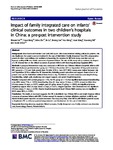Impact of family integrated care on infants’ clinical outcomes in two children’s hospitals in China: a pre-post intervention study
| dc.contributor.author | He, S-W | |
| dc.contributor.author | Xiong, Y-E | |
| dc.contributor.author | Zhu, L-H | |
| dc.contributor.author | Lv, B | |
| dc.contributor.author | Gao, X-R | |
| dc.contributor.author | Xiong, H | |
| dc.contributor.author | Wang, H | |
| dc.contributor.author | Shi, H-R | |
| dc.contributor.author | Latour, Jos M | |
| dc.date.accessioned | 2018-06-07T12:39:46Z | |
| dc.date.issued | 2018-06-05 | |
| dc.identifier.issn | 1720-8424 | |
| dc.identifier.issn | 1824-7288 | |
| dc.identifier.other | 65 | |
| dc.identifier.uri | http://hdl.handle.net/10026.1/11624 | |
| dc.description.abstract |
BACKGROUND: Most Neonatal Intensive Care Units (NICUs) in China have restricted visiting policies for parents. This also implicates that parents are not involved in the care of their infant. Family Integrated Care (FIC), empowering parents in direct care delivery and decisions, is becoming the standard in NICUs in many countries and can improve quality-of-life and health outcomes of preterm infants. The aim of this study was to evaluate the impact of a FIC intervention on the clinical outcomes of preterm infants with Bronchopulmonary Dysplasia (BPD). METHODS: A pre-post intervention study was conducted at NICUs in two Chinese children's hospitals. Infants with BPD were included: pre-intervention group (n = 134) from December 2015 to September 2016, post-intervention (FIC) group (n = 115) and their parents from October 2016 to June 2017. NICU nurses were trained between July and September 2016 to deliver the FIC intervention, including parent education and support. Parents had to be present and care for their infant minimal three hours a day. The infants' outcome measures were length-of-stay, breastfeeding, weight gain, respiratory and oxygen support, and parent hospital expenses. RESULTS: Compared with control group (n = 134), the FIC group (n = 115) had significantly increased breastfeeding rates (83% versus 71%, p = 0.030), breastfeeding time (31 days versus 19 days, p < 0.001), enteral nutrition time (50 days versus 34 days, p < 0.001), weight gain (29 g/day versus 23 g/day, p = 0.002), and significantly lower respiratory support time (16 days versus 25 days, p < 0.001). Oxygen Exposure Time decreased but not significant (39 days versus 41 days p = 0.393). Parents hospital expenses in local Chinese RMB currency was not significant (84 K versus 88 K, p = 0.391). CONCLUSION: The results of our study suggests that FIC is feasible in two Chinese NICUs and might improve clinical outcomes of preterm infants with BPD. Further research is needed to include all infants admitted to NICUs and should include parent reported outcome measures. Our study may help other NICUs with limited parental access to implement FIC to enhance parental empowerment and involvement in the care of their infant. | |
| dc.format.extent | 65- | |
| dc.format.medium | Electronic | |
| dc.language | en | |
| dc.language.iso | en | |
| dc.publisher | BioMed Central | |
| dc.subject | Bronchopulmonary dysplasia | |
| dc.subject | Clinical outcome | |
| dc.subject | Family integrated care | |
| dc.subject | Family centered care | |
| dc.subject | Intensive care | |
| dc.subject | Neonatology | |
| dc.subject | Parents | |
| dc.subject | Preterm infants | |
| dc.title | Impact of family integrated care on infants’ clinical outcomes in two children’s hospitals in China: a pre-post intervention study | |
| dc.type | journal-article | |
| dc.type | Comparative Study | |
| dc.type | Journal Article | |
| dc.type | Multicenter Study | |
| plymouth.author-url | https://www.webofscience.com/api/gateway?GWVersion=2&SrcApp=PARTNER_APP&SrcAuth=LinksAMR&KeyUT=WOS:000434178900001&DestLinkType=FullRecord&DestApp=ALL_WOS&UsrCustomerID=11bb513d99f797142bcfeffcc58ea008 | |
| plymouth.issue | 1 | |
| plymouth.volume | 44 | |
| plymouth.publication-status | Published | |
| plymouth.journal | Italian Journal of Pediatrics | |
| dc.identifier.doi | 10.1186/s13052-018-0506-9 | |
| plymouth.organisational-group | /Plymouth | |
| plymouth.organisational-group | /Plymouth/Faculty of Health | |
| plymouth.organisational-group | /Plymouth/Faculty of Health/School of Nursing and Midwifery | |
| plymouth.organisational-group | /Plymouth/REF 2021 Researchers by UoA | |
| plymouth.organisational-group | /Plymouth/REF 2021 Researchers by UoA/UoA03 Allied Health Professions, Dentistry, Nursing and Pharmacy | |
| plymouth.organisational-group | /Plymouth/Research Groups | |
| plymouth.organisational-group | /Plymouth/Research Groups/Institute of Health and Community | |
| plymouth.organisational-group | /Plymouth/Research Groups/Plymouth Institute of Health and Care Research (PIHR) | |
| plymouth.organisational-group | /Plymouth/Users by role | |
| plymouth.organisational-group | /Plymouth/Users by role/Academics | |
| dc.publisher.place | England | |
| dcterms.dateAccepted | 2018-05-28 | |
| dc.rights.embargodate | 2018-6-15 | |
| dc.identifier.eissn | 1824-7288 | |
| dc.rights.embargoperiod | No embargo | |
| rioxxterms.versionofrecord | 10.1186/s13052-018-0506-9 | |
| rioxxterms.licenseref.uri | http://www.rioxx.net/licenses/all-rights-reserved | |
| rioxxterms.licenseref.startdate | 2018-06-05 | |
| rioxxterms.type | Journal Article/Review |


